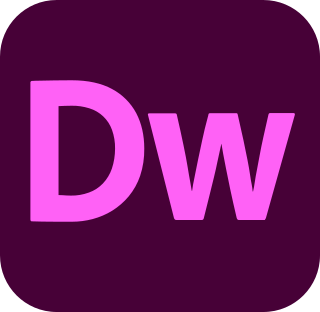
A web application is application software that runs on a web server, unlike computer-based software programs that are run locally on the operating system (OS) of the device. Web applications are accessed by the user through a web browser with an active network connection. These applications are programmed using a client–server modeled structure—the user ("client") is provided services through an off-site server that is hosted by a third-party. Examples of commonly-used web applications include: web-mail, online retail sales, online banking, and online auctions.

Adobe Dreamweaver is a proprietary web development tool from Adobe Inc. It was created by Macromedia in 1997 and developed by them until Macromedia was acquired by Adobe Systems in 2005.
A user interface markup language is a markup language that renders and describes graphical user interfaces and controls. Many of these markup languages are dialects of XML and are dependent upon a pre-existing scripting language engine, usually a JavaScript engine, for rendering of controls and extra scriptability.
JSON is an open standard file format and data interchange format that uses human-readable text to store and transmit data objects consisting of attribute–value pairs and arrays. It is a common data format with diverse uses in electronic data interchange, including that of web applications with servers.
Echo is a web application framework created by the company NextApp. The latest iteration, Echo3, allows writing applications in either server-side Java or client-side JavaScript. Server-side applications do not require developer knowledge of HTML, HTTP, or JavaScript. Client-side JavaScript-based applications do not require a server, but can communicate with one via AJAX.
This is a comparison of widget engines. This article is not about widget toolkits that are used in computer programming to build graphical user interfaces.

Dojo Toolkit is an open-source modular JavaScript library designed to ease the rapid development of cross-platform, JavaScript/Ajax-based applications and web sites. It was started by Alex Russell, Dylan Schiemann, David Schontzler, and others in 2004 and is dual-licensed under the modified BSD license or the Academic Free License.

Aptana, Inc. is a company that makes web application development tools for use with a variety of programming languages. Aptana's main products include Aptana Studio, Aptana Cloud and Aptana Jaxer.
jQuery is a JavaScript library designed to simplify HTML DOM tree traversal and manipulation, as well as event handling, CSS animation, and Ajax. It is free, open-source software using the permissive MIT License. As of May 2019, jQuery is used by 73% of the 10 million most popular websites. Web analysis indicates that it is the most widely deployed JavaScript library by a large margin, having at least 3 to 4 times more usage than any other JavaScript library.
This is a comparison of web frameworks that are heavily reliant on JavaScript code for their behavior.
XPages is an IBM implementation of JavaServer Faces with a server side JavaScript runtime and the built-in NoSQL database IBM Domino. It allows data from IBM Notes and Relational Databases to be displayed to browser clients on all platforms.
ZK is an open-source Ajax Web application framework, written in Java, that enables creation of graphical user interfaces for Web applications with little required programming knowledge.
Mustache is a web template system with implementations available for ActionScript, C++, Clojure, CoffeeScript, ColdFusion, Common Lisp, Crystal, D, Dart, Delphi, Elixir, Erlang, Fantom, Go, Haskell, Io, Java, JavaScript, Julia, Lua, .NET, Objective-C, OCaml, Perl, PHP, Pharo, Python, R, Racket, Raku, Ruby, Rust, Scala, Smalltalk, Swift, Tcl, CFEngine and XQuery.
There are different JavaScript charting libraries available. Below is a comparison of which features are available in each.

Webix is a JavaScript/HTML5/CSS3 UI toolkit for developing complex and dynamic cross-platform web applications. The framework is developed by the IT outsourcing company XB Software, headquartered in Minsk, Belarus.

OpenUI5 is a JavaScript application framework designed to build cross-platform, responsive, enterprise-ready applications. It is an open-source project maintained by SAP SE available under the Apache 2.0 license and open to contributions. OpenUI5's core is based on JavaScript, jQuery, and LESS. The library's feature set includes model–view–controller patterns, data binding, its own UI-element library, and internationalisation support.
This is a list of articles related to the JavaScript programming language.




